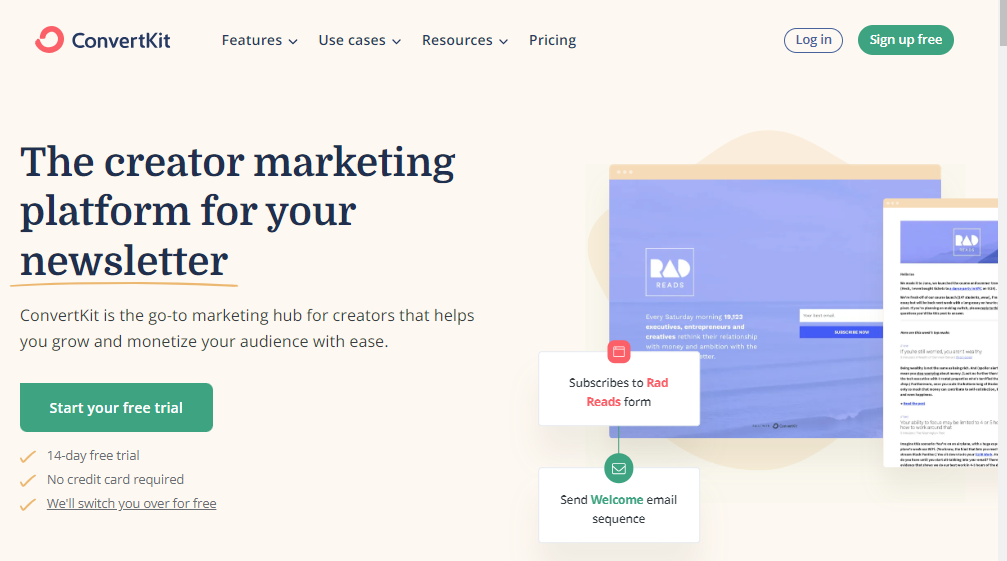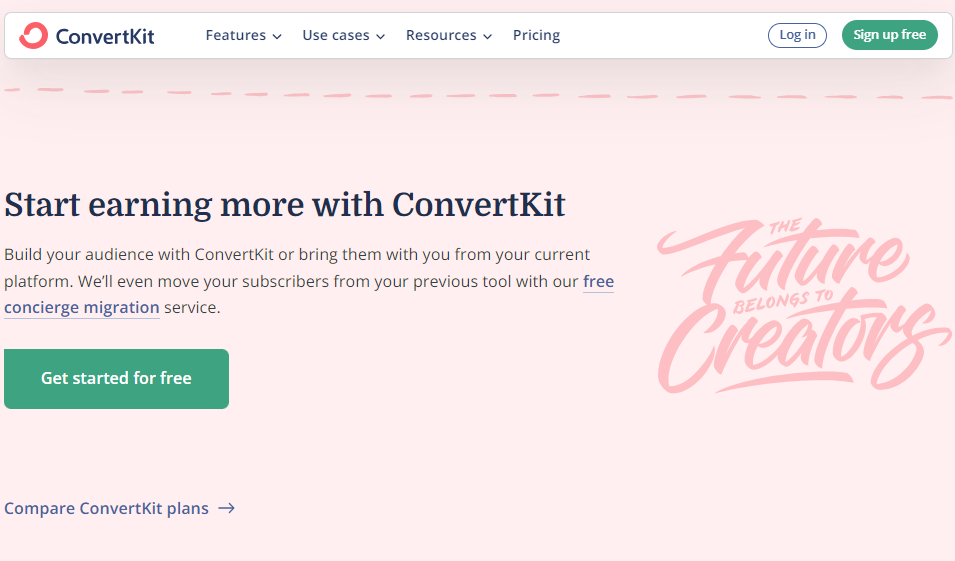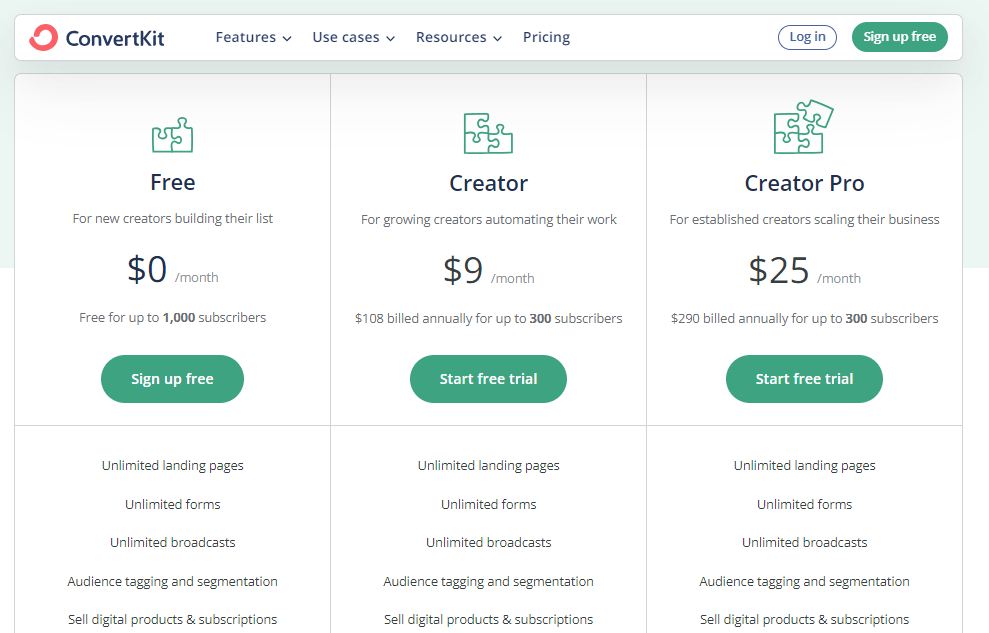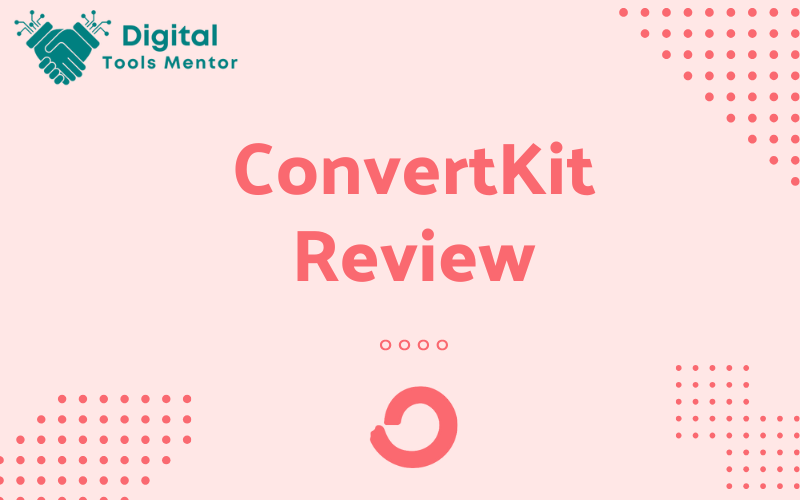ConvertKit Review 2025
Welcome to our comprehensive ConvertKit review for 2025, where we delve into the latest advancements and features of this popular email marketing platform. In a digital landscape where effective communication with your audience is paramount, ConvertKit continues to shine as a versatile tool tailored to content creators, entrepreneurs, and businesses of all sizes. As we navigate through the year, it’s crucial to stay ahead in the realm of email marketing, and in this review, we’ll explore how ConvertKit’s array of functionalities, user-friendly interface, and automation prowess can contribute to nurturing meaningful connections, driving engagement, and ultimately, achieving your marketing goals.

ConvertKit Features
Incorporating these key features into your email marketing strategy using ConvertKit can elevate your campaigns, streamline your workflow, and help you connect with your audience in more meaningful ways.
1.Tagging and Segmentation
ConvertKit’s robust tagging and segmentation system enables you to categorize your subscribers based on their behavior, preferences, and interactions. This feature empowers you to send highly targeted and relevant emails, ensuring that your audience receives content tailored to their specific interests. By delivering personalized messages, you can boost engagement and conversion rates while fostering a deeper connection with your subscribers.
2. Visual Automation Builder
With ConvertKit’s intuitive visual automation builder, creating complex email sequences becomes a breeze. This drag-and-drop interface allows you to design intricate workflows, from welcome series to product launches, without requiring advanced technical skills. Automations can be triggered by subscriber actions, making it simple to deliver the right content at the right time, nurturing leads and guiding them through your sales funnel.
3. Customizable Signup Forms
ConvertKit offers a variety of customizable signup forms that seamlessly integrate with your website or landing pages. Whether it’s a simple inline form or a eye-catching modal popup, you can tailor the design to match your brand and capture subscribers effectively. The flexibility to embed forms wherever you need on your site enhances your ability to grow your email list and capture leads effortlessly.
4. Subscriber Preferences and Consent
In compliance with data privacy regulations like GDPR, ConvertKit provides features that enable you to manage subscriber preferences and obtain proper consent for collecting and using their data. Subscribers can select the types of content they want to receive, ensuring that you respect their choices while maintaining a transparent and trustworthy relationship.
5. Responsive Email Templates
ConvertKit offers a collection of responsive email templates that are designed to look great on various devices and screen sizes. These templates can be customized to match your branding, and they allow you to create visually appealing emails without the need for design skills. Whether you’re sending newsletters or promotional emails, these templates help you maintain a professional and consistent appearance across your campaigns.
ConvertKit Pros & Cons
ConvertKit Pros
1.User-Friendly Interface
ConvertKit’s intuitive interface makes it easy for both beginners and experienced marketers to navigate and utilize its features. The platform’s simplicity ensures that you can quickly set up campaigns, create automations, and manage your subscriber list without a steep learning curve.
2. Effective Email Sequences
ConvertKit’s visual automation builder empowers you to craft intricate email sequences that nurture leads and guide them through your sales funnel. This capability is particularly beneficial for engaging subscribers at various stages of their customer journey, ultimately boosting conversion rates.
3. Tagging and Segmentation Power
The robust tagging and segmentation system allows you to send highly targeted and personalized emails. By understanding your subscribers’ preferences and behaviors, you can tailor content to resonate with their interests, leading to higher engagement and improved campaign performance.
4. Transparent Pricing Model
ConvertKit’s pricing is based on the number of subscribers you have, ensuring that you only pay for what you use. As your subscriber list grows, you can easily scale your plan without any hidden fees, making it a cost-effective solution for businesses of all sizes.
5. Customizable Signup Forms
ConvertKit provides a range of customizable signup forms that seamlessly integrate with your website. These forms can be designed to match your branding, helping you capture leads and grow your email list while maintaining a consistent look and feel.
ConvertKit Cons
1.Limited A/B Testing
ConvertKit’s A/B testing capabilities are somewhat limited compared to some other email marketing platforms. While you can test subject lines, you may find fewer options for testing other elements like email content or sending times.
2. Design Constraints
While ConvertKit offers responsive email templates, the design customization options might be less extensive compared to specialized email design tools. Advanced design changes might require some knowledge of HTML and CSS.
3. Learning Curve for Automations
While the visual automation builder is user-friendly, creating more complex automations might still require a bit of trial and error, especially for those new to email marketing automation concepts.
ConvertKit Pricing
ConvertKit offers straightforward and transparent pricing that adapts to your needs as your email list grows. Their plans are based on the number of subscribers you have, ensuring you only pay for the resources you actually use. Starting with a free plan for up to 1,000 subscribers, ConvertKit’s paid plans offer more advanced features like automation, integrations, and customizable forms. As your subscriber count increases, you can seamlessly upgrade your plan to access additional tools that can enhance your email marketing efforts. This pricing model provides businesses and creators with a scalable solution that accommodates both small and large subscriber lists, making ConvertKit a flexible and cost-effective choice for those looking to effectively engage their audience through targeted email campaigns.
ConertKit Pricing Table
| Plan | No. of Contacts | Price per Month |
| Free | 300 | $ 0 |
| Creator | 300 | $ 15 |
| Creator Pro | 300 | $ 29 |
ConvertKit Pricing Table
ConvertKit Screenshots




Conclusion
In conclusion, ConvertKit emerges as a powerful email marketing platform that empowers marketers, content creators, and businesses to foster genuine connections with their audience. With its user-friendly interface, robust automation capabilities, and personalized communication tools, ConvertKit simplifies the process of crafting engaging email campaigns that drive results. While it may have some limitations in terms of design customization and A/B testing options, its strengths in segmentation, automation, and subscriber management make it a valuable asset for nurturing leads and guiding them through a tailored customer journey. Whether you’re a beginner seeking to establish a strong email marketing foundation or a seasoned marketer aiming to enhance your strategy, ConvertKit’s intuitive features and scalable pricing model position it as a versatile solution that can support your efforts to connect, engage, and convert in the dynamic world of digital marketing.
ConvertKit FAQ’s
1. Is there a free version of ConvertKit available?
Yes, ConvertKit offers a free plan that supports up to 1,000 subscribers. This plan provides basic email marketing features to help you get started.
2. Can I migrate from another email marketing platform to ConvertKit?
Absolutely! ConvertKit offers tools and resources to help you smoothly migrate your subscriber list and content from other platforms, ensuring a seamless transition.
3. How does ConvertKit’s automation work?
ConvertKit’s automation allows you to create customized workflows that trigger specific actions based on subscriber behavior or certain conditions. This helps you deliver targeted content and maintain engagement.
4. Can I design custom email templates with ConvertKit?
While ConvertKit offers responsive email templates, extensive design customization might require some HTML and CSS knowledge. The focus is on simplicity and functionality rather than intricate design.
5. What is the pricing structure for ConvertKit’s paid plans?
ConvertKit’s pricing is based on the number of subscribers you have. As your subscriber list grows, you can easily upgrade your plan to access more advanced features like automation and integrations.
6. Does ConvertKit offer A/B testing for emails?
Yes, ConvertKit allows you to A/B test subject lines, helping you optimize your email open rates. However, it might have fewer A/B testing options compared to some other platforms.
7. Can I integrate ConvertKit with other tools I use?
ConvertKit offers a range of integrations with popular tools like WordPress, Shopify, and more. This allows you to connect your email marketing efforts with your other marketing and e-commerce platforms.
8. How does ConvertKit help with subscriber segmentation?
ConvertKit provides a tagging and segmentation system that lets you categorize subscribers based on their interests, behavior, and engagement. This enables you to send highly targeted content to different segments.
9. Is ConvertKit suitable for e-commerce businesses?
Yes, ConvertKit’s automation features are particularly useful for e-commerce businesses. You can create automated workflows for product recommendations, abandoned cart reminders, and more.
10. How does ConvertKit handle compliance with data privacy regulations?
ConvertKit provides tools to help you manage subscriber consent and preferences in compliance with regulations like GDPR. Subscribers can choose the types of emails they want to receive, ensuring transparency and respect for their choices.
ConvertKit Alternatives
1. HubSpot
HubSpot is an all-in-one marketing platform that offers a wide range of tools for inbound marketing, sales, and customer service. While it provides email marketing features, it also includes CRM, automation, lead nurturing, content creation, and analytics. HubSpot’s comprehensive suite is suitable for businesses looking for a holistic approach to managing their marketing efforts.
2. Flodesk
Flodesk is a visually appealing email marketing platform known for its beautifully designed templates and user-friendly interface. It’s particularly popular among creative entrepreneurs and bloggers. Flodesk emphasizes simplicity in email design while offering automation capabilities. It’s a great choice for those who prioritize aesthetic and engaging email campaigns.
3. ClickFunnels
ClickFunnels is a sales funnel and landing page builder that enables businesses to create marketing funnels for lead generation, sales, and conversions. While it’s not solely an email marketing platform, it does offer email integration and automation features. ClickFunnels is ideal for businesses looking to build sales funnels and optimize their conversion processes.



